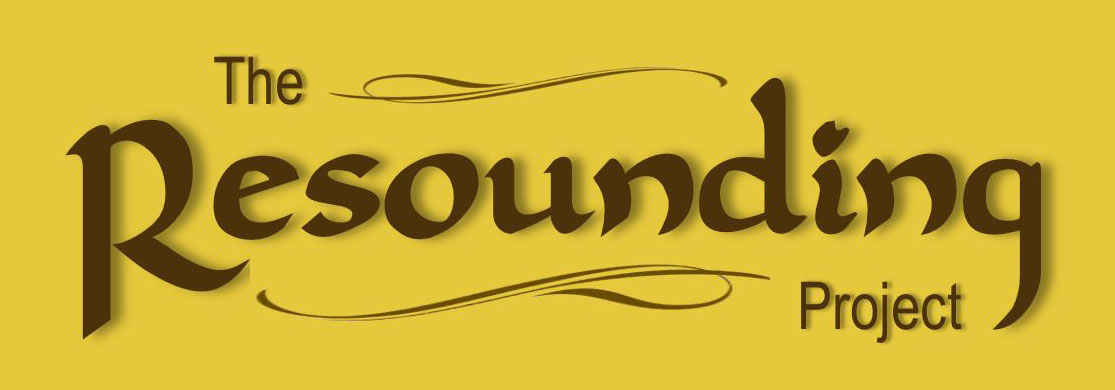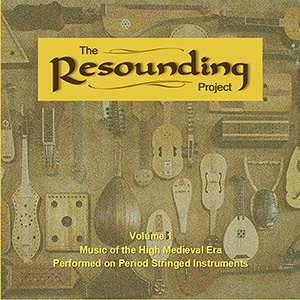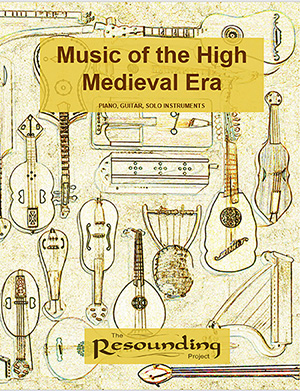

| The Project |
The Music |
The Instruments |
Blogs & Contact |

 |
MUSIC OF THE HIGH MEDIEVAL ERA PERFORMED ON PERIOD STRINGED INSTRUMENTS
This collection uses authentic instruments of the 11th-13th Centuries to perform fifteen songs from that time. The instrumentals sample five regions of Medieval Europe. |
| |
 |
 |
Now available... MUSIC OF THE HIGH MEDIEVAL ERA (Music book) This companion music book for Music of the High Medieval Era is illustrated with sketches of the unique instruments heard in the audio album. Accompaniments and chord symbols have been created for most tunes, with consideration of the likely instrumentation and styles of the time. The songs are well-suited for solos or ensembles in a variety of instrumentations. Find it at Amazon, B&N, etc... |
The High Medieval Period (roughly the 11th - 13th Century) was quite diverse musically. Well before the age of standardized orchestration, there was rich diversity in instruments allowing much experimentation with musical style and composition. Especially among the strings, we see instruments specifically designed to suit the player and the genre.
Since we have no extant instruments from this period (wood is not very durable) much of what we know is via the art. Granted, some artists take creative license, but taken as a whole I believe early art work provides a good depiction of instrumentation.
The songs on this album were recorded on instruments modeled after two primary sources--the Cantigas de Santa Maria from the 13th Century court of Alfonso X and the sculpted Twenty-four Elders' Instruments over the Portico de Gloria in the Santiago de Compostola cathedral.
Most of these songs have accompanying lyrics. For this project, however, the instruments are showcased. I typically added or highlighted a different instrument in each successive verse, ending with all instruments in unison. Realizing there are varying opinions regarding the "correct" interpretation, voicing, tempo, or phrasing, I chose to err on the side of presenting the acoustics and performance characteristics of the instruments. Simplicity and clarity of tones were favored over potentially more creative performances.
| DISCOGRAPHY |
| TITLE | DESCRIPTION | INSTRUMENTATION (by verse)* | |
| 1 | Stella Splendens | "Splendid Star" is a polyphonic song, also from the Llibre Vermell de Montserrat. | 1 - CSM10 citole on both melody and accompaniment. 2 - Add CSM70 psaltery. 3 - Add metal whistle. 4 - Add Koninklijke rebek. 5 - Add CSM50 psaltery (hammered). 6 - Add PG19 lion harp. End lion harp and CSM10 citole. |
| 2 | Lamento di Tristano | A folk-style estampie found with 116 other songs in a 14th Century, Italian manuscript. | 1 - Both parts played on the CSM10 citole. 2 - Add Lincoln Cathedral citole. |
| 3 | La Rotta | A rotta is a lively Italian dance tune, typically played after a slower estampie. This rotta usually follows "Lamento di Tristano". | 1 - CSM10 citole and frame drum. 2 - Add CSM90 gittern. 3 - Add CSM50 psaltery (hammered). 4 - Add PG19 lion harp. |
| 4 | Cuncti Simus Concanentes | Translated "Let us sing together", this virelai was found in the Llibre Vermell de Montserrat in a monastery near Barcelona. The unknown author wrote that the purpose was to provide wholesome songs "Because the pilgrims wish to sing and dance while they keep their watch at night in the church." | 1 - CSM 10 citole and brass finger cymbals. 2 - Add frame drum and Koninklijke rebec. 3 - Add CSM50 psaltery (hammered). 4 - Drum, rebec and bells. |
| 5 | Douce Dame Jolie | A virelai by the 14th Century French composer Guillaume de Machaut. | 1 - CSM10 citole (strummed), CSM50 psaltery (hammered). 2 - Add CSM10 citole (plucked). 3 - Add CSM70 psaltery. 4 - Only CSM10 citole and PG19 harp. 5 - All with added CSM210 viol. |
| 6 | Strela Do Dia | Cantiga 100, one of 420 Cantigas de Santa Maria attributed to Alfonso X (1221–1284). | 1 - Frame drum, CSM citole (strummed), PG19 harp (melody) 2 - Add CSM10 citole on melody. 3 - CSM50 psaltery (hammered) and CSM10 citole, both on melody. 4 - CSM70 psaltery and CSM10 citole, both on melody. 5 - Lincoln Cathedral citole and CSM10 citole, both on melody. 6 - All. |
| 7 | Ben Pod' a Sennor Sen | Cantiga 101 of the Cantigas de Santa Maria. | 1 - CSM10 citole (argeggio and melody), frame drum, brass finger cymbals. 2 - Add metal whistle and CSM10 citole (strummed). 3 - Add PG19 harp. 4 - Add PG9 citole. 5 - Add CSM50 psaltery (hammered) and CSM. 6 - All with added CSM210 viol. |
| 8 | A Virgen Mui Groriosa | Cantiga 42 of the Cantigas de Santa Maria. | 1 - PG19 harp and CSM10 citole. 2 - Add metal whistle. 3 - Add CSM50 psaltery (hammered). |
| 9 | Como Poden Per Sas Culpas | Cantiga 166 of the Cantigas de Santa Maria. | Frame drum, brass finger cymbals, CSM10 citole (arpeggio) throughout. 1 - CSM10 citole (melody). 2 - Add metal whistle and CSM10 citole (strummed). 3 - Add PG19 lion harp. 4 - Add PG9 citole. 5 - Add CSM50 psaltery (hammered). 6 - Add CSM250 viol. |
| 10 | Rosa Das Rosas | Cantiga 10 of the Cantigas de Santa Maria. | 1 - Parma Citole (melody), CSM10 citole. 2 - Add CSM10 citole and brass bells (melody). 3 - Add PG19 harp. 4 - Add Stuttgart citole. 5 - Add CSM50 psaltery (hammered) and CSM250 viol. End Parma citole, CSM10 citole. |
| 11 | Adoro Te Devote | A Eucharistic hymn composed by Thomas Aquinas. This recording uses the droning strings of the cranked organistrum, a forerunner of the hurdy-gurdy. | 1 - Portico de Gloria organistrum. 2 - Add CSM70 psaltery. |
| 12 | Mandad’ei Comigo | A cantiga by the 13th Century joglar Martin Codax. This tune, "Word Came Today", is about a friend returning from battle. | Introduction on frame drum, brass bells, CSM210 viol. 1 - Lincoln Cathedral citole. 2 - CSM10 citole. 3 - CSM50 psaltery (hammered). 4 - All with added CSM70 psaltery. 5 - CSM70 psaltery and frame drum. 6 - All. |
| 13 | Palastinalied | Written in the early 13th Century by Walther von der Vogelweide, this Crusader's song is from the perspective of a pilgrim entering the Holy Land. Note the march-style rhythm. | All verses - frame drum, CSM210 viol, CSM10 citole (strummed), CSM290 psaltery. 1 - CSM** gittern 2 - CSM** gittern, CSM10 citole (plucked) 3 - CSM70 psaltery 4 - CSM50 psaltery (hammered) 5 - PG19 harp 6 - All |
| 14 | Estampie Royale 2 | The estampie was a popular 13th Century French dance genre. Either vocal or instrumental, it consisted of repeated phases called puncta. | CSM10 citole strummed (all verses). 1 - CSM10 citole on melody. 2 - Lincoln Cathedral citole and frame drum. 3 - PG19 lion harp and frame drum. |
| 15 | Veni Sancte Spiritus | This is one of four medieval songs preserved in the Missale Romanum, published in 1570 following the Council of Trent. Although the exact, original notation is vague, this arrangement is a mosaic of the most common extant tunes. | Both parts played on the CSM70 psaltery. |
*see INSTRUMENTS page for more information
FOR THOSE INTERESTED IN THE TECHNICAL ASPECTS...
These pieces were recorded and produced using Presonus Studio One Professional 4 and Celemony Melodyne. My goal was to preserve the tonal quality of each instrment, in order to recreate a historically accurate artifact. I removed ambient noise (not the noises of string squeaks and overtones) and corrected my own playing deficiencies such as tempo variation and wrong notes. When a repetitive section was "perfected", that loop was used for all repeated verses. The final mix was enhanced with a touch of reverb and delay in order to offset the deadness of my recording space.